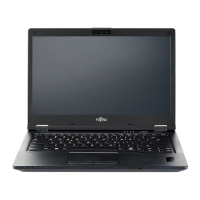Security functions
Trusted Platform Module - TPM (device dependent)
TPMTrusted PlatformModul e
To use the T PM , you must enable the TPM in the BIO S Setup before the software
is installed. The condition for this is that you have assigned at least the supervisor
password (see "
Securit y functions", Page 52).
For how to call up and operate the BI OS S etup Utility,seeSection"
Settings
in BIOS Setup Utility", Page 74.
Enabling TPM
• Requirement: You have assigned a supervisor password (see "Security functions " , Page 52).
► Call BIOS Setup and sel
ect the Security menu.
► Mark the TPM (Security Chip ) S etting field and press the Enter key.
► Select the "Security
Chip" "En a ble d" entry to enable the TPM
Once you have enabled the TPM by reboo ting, the Clear Security Chip menu item appears.
If the T PM was alrea
dy in use, you can use Clear Security Chip to clear the holder in the
TPM. W ith Enabled,
all secret keys (e.g. SRK - Storage R oot Keys, AIK - Atte station
Identity Keys etc
.) generated by applications are deleted.
Ta ke note tha t you
can then no longer access the data you have
encrypted on the
holder-based keys!
► Select the Exit S
aving Changes option in the Exit menu.
► Press the Enter key and select Yes.
The notebook r
estarts and the TPM is switched on after the reboot.
Disabling TPM
• Requirement: You have assigned a supervisor password (see "Security functions " , Page 52).
► Call BIOS Setup and select the Security menu.
► Mark the TPM (Security Chip ) S etting field and press the Enter key.
► Select the "Security Ch ip " "Disabled" entry to deactivate the TPM.
► From the Exit menu, choose the option Exit Saving Changes.
► Press the Enter key and select Yes.
The notebook will now reboot with TPM deactivated.
Fujitsu 57

